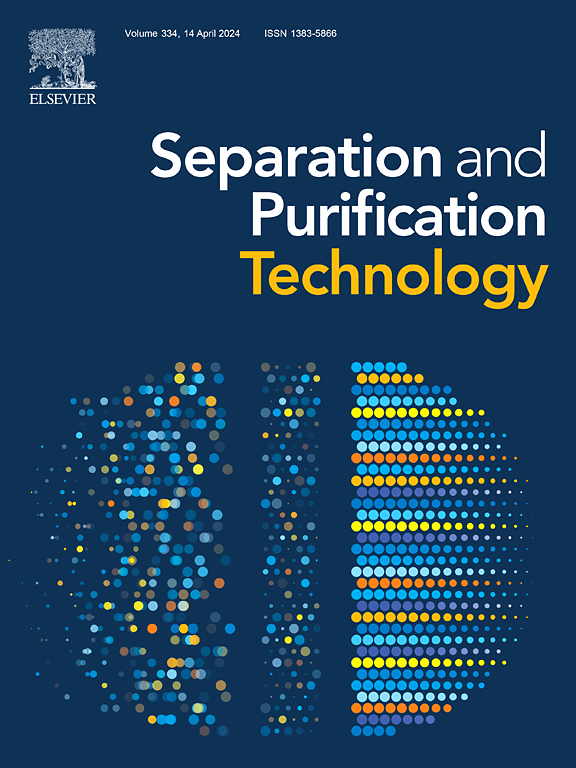MOF/聚多巴胺改性MXene基混合基质膜去除实际废水中的全氟烷基和多氟烷基物质
IF 8.1
1区 工程技术
Q1 ENGINEERING, CHEMICAL
引用次数: 0
摘要
全氟烷基和多氟烷基物质(PFAS)是持续出现的水污染物,从水体中清除它们是一项严峻的挑战。在这项工作中,研究了使用先进的醋酸纤维素(CA)基混合基质膜(MMMs)从合成和真实废水中去除长链和短链PFAS。该膜包含由铁基金属有机框架(MOF)组成的工程纳米填料(DMMIL),在聚多巴胺涂层的MXene纳米片上原位生长(PD@Ti3C2Tx)。纳米填料和膜是彻底表征与显微镜和光谱学技术阵列。这些方法包括SEM, EDX, XRD, FTIR, XPS, AFM,水接触角和zeta电位测量,以检查纳米材料的性能以及纳米填料负载对膜的微观形态,表面纹理,润湿性和电离性能的影响。在合成废水系统中,与原始CA膜相比,最佳纳米填料负载(50%DMMIL/CA)的膜的水通量提高了1.42倍,全氟辛酸(PFOA)的去除率提高了1.65倍。对PFOA过滤后再用去氧水清洗的膜进行了污染试验,产膜通量回收率高达68%,50%DMMIL/CA膜在5个循环后通量回收率为54%。在合成废水和实际废水中测试了该膜对长链和短链PFAS的去除效果。在实际废水样品中,50%DMMIL/CA膜去除60%的PFOA, 57%的全氟庚酸(PFHpA)和55%的全氟己酸(PFHxA),以及其他有机和无机污染物。本文章由计算机程序翻译,如有差异,请以英文原文为准。

MOF/Polydopamine-modified MXene based mixed matrix membrane for per- and polyfluoroalkyl substances removal from real wastewater
Per- and poly-fluoroalkyl substances (PFAS) are persistent emerging water contaminants and their removal from water bodies is a rigorous challenge. In this work, the removal of long and short chain PFAS from synthetic and real wastewater is examined by using advanced cellulose acetate (CA) based mixed-matrix membranes (MMMs). The membranes incorporate engineered nanofillers (DMMIL) consisting of iron-based metal–organic framework (MOF), in-situ grown in polydopamine-coated MXene nanosheets (PD@Ti3C2Tx). The nanofillers and membranes are thoroughly characterized with an array of microscopy and spectroscopy techniques. These include SEM, EDX, XRD, FTIR, XPS, AFM, water contact angle, and zeta potential measurements to examine the properties of nanomaterials and the effect of nanofiller loading on the microscopic morphology, surface texture, wettability, and ionization properties of membranes. The membrane with optimal nanofiller loading (50%DMMIL/CA) exhibited 1.42-fold enhanced water flux and 1.65-fold enhanced perfluorooctanoic acid (PFOA) rejection compared to the pristine CA membrane in the synthetic wastewater system. The fouling test was run for cycles of PFOA filtration followed by cleaning with DI water, and the produced membranes showed up to 68% flux recovery, with 54% shown by the 50%DMMIL/CA membrane after 5 cycles. The membrane’s effectiveness in removing both long- and short-chain PFAS was tested in synthetic and real wastewater. In real wastewater samples, the 50%DMMIL/CA membrane removed 60% of PFOA, 57% of perfluoroheptanoic acid (PFHpA), and 55% of perfluorohexanoic acid (PFHxA), as well as other organic and inorganic pollutants.
求助全文
通过发布文献求助,成功后即可免费获取论文全文。
去求助
来源期刊

Separation and Purification Technology
工程技术-工程:化工
CiteScore
14.00
自引率
12.80%
发文量
2347
审稿时长
43 days
期刊介绍:
Separation and Purification Technology is a premier journal committed to sharing innovative methods for separation and purification in chemical and environmental engineering, encompassing both homogeneous solutions and heterogeneous mixtures. Our scope includes the separation and/or purification of liquids, vapors, and gases, as well as carbon capture and separation techniques. However, it's important to note that methods solely intended for analytical purposes are not within the scope of the journal. Additionally, disciplines such as soil science, polymer science, and metallurgy fall outside the purview of Separation and Purification Technology. Join us in advancing the field of separation and purification methods for sustainable solutions in chemical and environmental engineering.
 求助内容:
求助内容: 应助结果提醒方式:
应助结果提醒方式:


